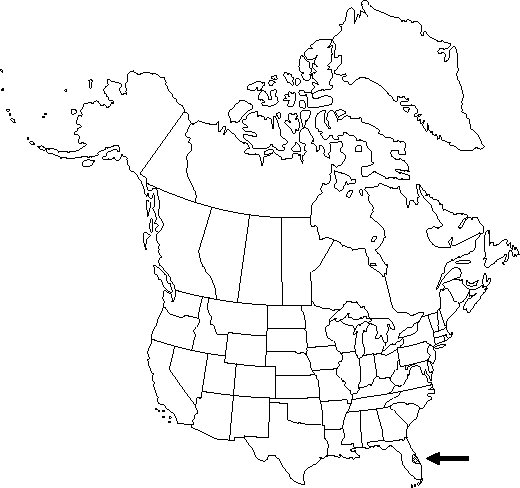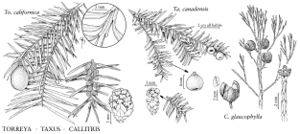Difference between revisions of "Callitris glaucophylla"
Telopea 2: 731. 1986.
FNA>Volume Importer |
imported>Volume Importer |
||
| (One intermediate revision by the same user not shown) | |||
| Line 8: | Line 8: | ||
}} | }} | ||
|common_names=White cypress-pine | |common_names=White cypress-pine | ||
| + | |special_status={{Treatment/ID/Special_status | ||
| + | |code=I | ||
| + | |label=Introduced | ||
| + | }}{{Treatment/ID/Special_status | ||
| + | |code=F | ||
| + | |label=Illustrated | ||
| + | }} | ||
|basionyms= | |basionyms= | ||
|synonyms={{Treatment/ID/Synonym | |synonyms={{Treatment/ID/Synonym | ||
| Line 27: | Line 34: | ||
|elevation=0–10 m | |elevation=0–10 m | ||
|distribution=Fla.;Australia. | |distribution=Fla.;Australia. | ||
| + | |introduced=true | ||
|discussion=<p><i>Callitris glaucophylla</i> is naturalized in Brevard, Indian River, Orange, and Seminole counties in Florida.</p><!-- | |discussion=<p><i>Callitris glaucophylla</i> is naturalized in Brevard, Indian River, Orange, and Seminole counties in Florida.</p><!-- | ||
--><p>This inland Australian species is sometimes united with the eastern coastal <i>Callitris</i> columellaris F. Mueller under that name or distinguished at varietal rank (<i></i>var.<i> campestris</i> Silba). The names <i>C. glauca</i> R. Brown ex R. T. Baker & H. G. Smith and C. hugelii (Carrière) Franco have been applied erroneously to it.</p> | --><p>This inland Australian species is sometimes united with the eastern coastal <i>Callitris</i> columellaris F. Mueller under that name or distinguished at varietal rank (<i></i>var.<i> campestris</i> Silba). The names <i>C. glauca</i> R. Brown ex R. T. Baker & H. G. Smith and C. hugelii (Carrière) Franco have been applied erroneously to it.</p> | ||
| Line 50: | Line 58: | ||
|publication title=Telopea | |publication title=Telopea | ||
|publication year=1986 | |publication year=1986 | ||
| − | |special status= | + | |special status=Introduced;Illustrated |
| − | |source xml=https:// | + | |source xml=https://bitbucket.org/aafc-mbb/fna-data-curation/src/2e0870ddd59836b60bcf96646a41e87ea5a5943a/coarse_grained_fna_xml/V2/V2_584.xml |
|genus=Callitris | |genus=Callitris | ||
|species=Callitris glaucophylla | |species=Callitris glaucophylla | ||
Latest revision as of 20:24, 5 November 2020
Shrubs or trees to 30 m. Bark brown, furrowed. Leaves in whorls of 3 (sometimes 4 or 5 when juvenile), usually glaucous, juvenile leaves 7–8 mm, mature leaves 1–3 mm with apex broadly acute. Pollen cones cylindric-oblong, 5–10 × 2–5 mm. Seed cones depressed-globose to ovoid, 1.2–2 cm, dark brown; peduncle 7–8 mm; scales thin, indistinctly dentate along margin, separating almost to base when mature, alternate ones short and narrow, larger ones angled, often sharply, toward apex. Seeds 4–5 mm, chestnut brown.
Habitat: Sand pine scrub and thickets, often near plantings of the species
Elevation: 0–10 m
Distribution

Introduced; Fla., Australia.
Discussion
Callitris glaucophylla is naturalized in Brevard, Indian River, Orange, and Seminole counties in Florida.
This inland Australian species is sometimes united with the eastern coastal Callitris columellaris F. Mueller under that name or distinguished at varietal rank (var. campestris Silba). The names C. glauca R. Brown ex R. T. Baker & H. G. Smith and C. hugelii (Carrière) Franco have been applied erroneously to it.
Selected References
None.
